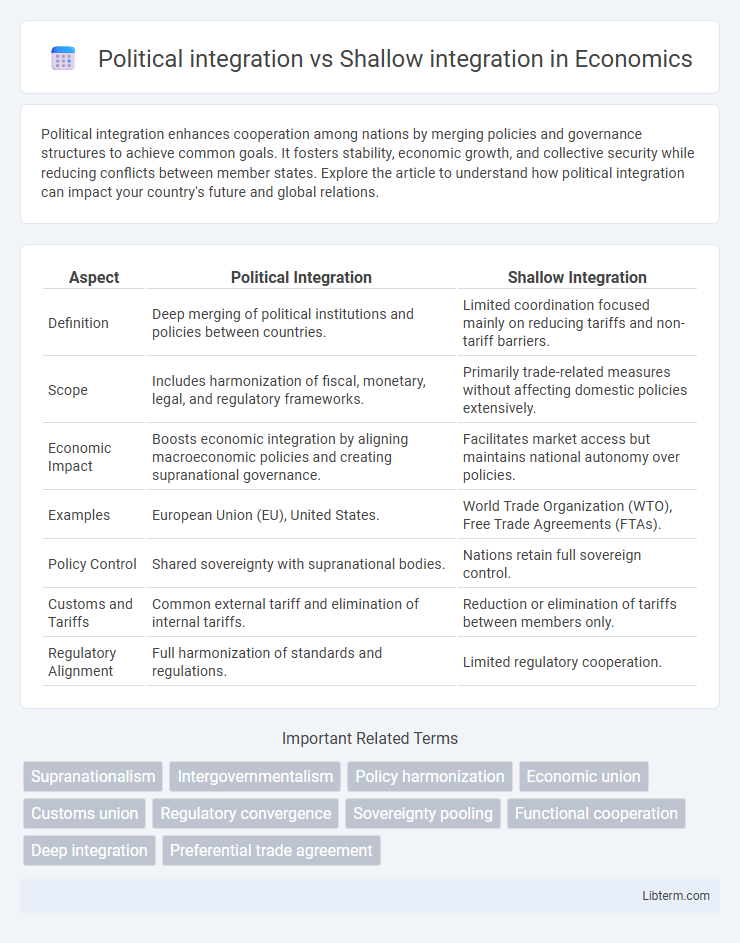Political integration enhances cooperation among nations by merging policies and governance structures to achieve common goals. It fosters stability, economic growth, and collective security while reducing conflicts between member states. Explore the article to understand how political integration can impact your country's future and global relations.
Table of Comparison
| Aspect | Political Integration | Shallow Integration |
|---|---|---|
| Definition | Deep merging of political institutions and policies between countries. | Limited coordination focused mainly on reducing tariffs and non-tariff barriers. |
| Scope | Includes harmonization of fiscal, monetary, legal, and regulatory frameworks. | Primarily trade-related measures without affecting domestic policies extensively. |
| Economic Impact | Boosts economic integration by aligning macroeconomic policies and creating supranational governance. | Facilitates market access but maintains national autonomy over policies. |
| Examples | European Union (EU), United States. | World Trade Organization (WTO), Free Trade Agreements (FTAs). |
| Policy Control | Shared sovereignty with supranational bodies. | Nations retain full sovereign control. |
| Customs and Tariffs | Common external tariff and elimination of internal tariffs. | Reduction or elimination of tariffs between members only. |
| Regulatory Alignment | Full harmonization of standards and regulations. | Limited regulatory cooperation. |
Understanding Political Integration
Political integration involves the deep unification of sovereign states through shared governance, legal frameworks, and coordinated policies, fostering a collective identity and long-term stability. It contrasts with shallow integration, which primarily concerns limited economic cooperation without significant political or institutional alignment. Understanding political integration requires analyzing mechanisms like supranational institutions, common decision-making processes, and the transfer of sovereignty that distinguish it from more superficial forms of collaboration.
Defining Shallow Integration
Shallow integration refers to the process of economic integration that primarily involves the removal of tariffs and non-tariff barriers without substantial harmonization of regulations or policies across countries. This approach contrasts with political integration, which entails deeper coordination and unification of political institutions and governance structures. Shallow integration facilitates increased trade and economic cooperation while maintaining national sovereignty over regulatory frameworks.
Key Characteristics of Political Integration
Political integration involves the unification of political institutions and policies across member states, enabling centralized decision-making and legal authority that supersedes national laws. It features common governance structures such as supranational bodies, a shared political agenda, and binding agreements that enforce compliance among members. Shallow integration, by contrast, primarily focuses on economic cooperation without significant political or institutional convergence.
Features of Shallow Integration
Shallow integration primarily involves the reduction of tariffs and non-tariff barriers between countries without extensive harmonization of policies or regulatory frameworks. It focuses on trade liberalization rather than deeper cooperation in areas such as fiscal policy, immigration, or judicial systems, maintaining national sovereignty over key political and economic decisions. This form of integration often results in increased cross-border trade but lacks the institutional depth seen in political integration.
Historical Examples of Both Integrations
The European Union exemplifies political integration through its adoption of common institutions like the European Parliament and a unified monetary policy under the Eurozone, facilitating deep economic and political convergence among member states. In contrast, the North American Free Trade Agreement (NAFTA), now USMCA, represents shallow integration by primarily removing tariff barriers without significant political or institutional harmonization, allowing member countries to maintain sovereign control over laws and regulations. Historical outcomes show political integration fosters stronger, centralized governance and shared policy-making, while shallow integration emphasizes economic cooperation with preserved national sovereignty.
Advantages of Political Integration
Political integration enhances economic cooperation by creating unified policies that reduce trade barriers and harmonize regulations across member states. It strengthens political stability and collective decision-making, allowing countries to address cross-border challenges more effectively. This deeper collaboration fosters long-term economic growth and regional development beyond the benefits achieved through shallow integration.
Limitations of Shallow Integration
Shallow integration primarily focuses on reducing tariffs and non-tariff barriers without harmonizing regulations or policies, leading to limited economic and political cohesion among member states. Its limitations include persistent regulatory divergences, weaker institutional frameworks, and minimal influence on cross-border investments and labor mobility. This restricts deeper market integration and the formation of a robust political union, undermining long-term regional stability and growth.
Political Integration: Challenges and Risks
Political integration involves unifying policies, regulations, and institutions across countries, facing challenges such as sovereignty loss, differing national interests, and socio-political resistance. Risks include economic disparities, governance complexities, and potential erosion of cultural identities, which can hinder consensus and effective policy implementation. Managing these challenges requires robust institutional frameworks and inclusive decision-making processes to balance national autonomy with collective goals.
Economic and Social Impacts Compared
Political integration fosters deep economic interdependence through unified policies, enhancing trade, investment, and labor mobility, which can lead to significant social cohesion and reduced inequality across member states. Shallow integration, concentrating on tariff reductions without harmonizing regulations or social policies, often results in limited economic benefits and persistent social disparities due to uneven implementation. Economic impacts under political integration include higher GDP growth and resilience to shocks, while social impacts feature improved social welfare systems and cross-border labor rights, contrasting with the fragmented outcomes typical of shallow integration.
Future Outlook: Deepening vs. Maintaining the Status Quo
Deepening political integration involves the transfer of sovereignty to supranational institutions, enabling comprehensive policy harmonization and unified decision-making, which can drive long-term stability and economic cohesion. In contrast, shallow integration prioritizes maintaining the status quo through intergovernmental cooperation without significant ceding of national authority, preserving flexibility but potentially limiting efficiency and collective action. Future outlooks favor deepening integration for addressing complex transnational challenges, though political resistance and sovereignty concerns may sustain reliance on shallow integration patterns.
Political integration Infographic

 libterm.com
libterm.com